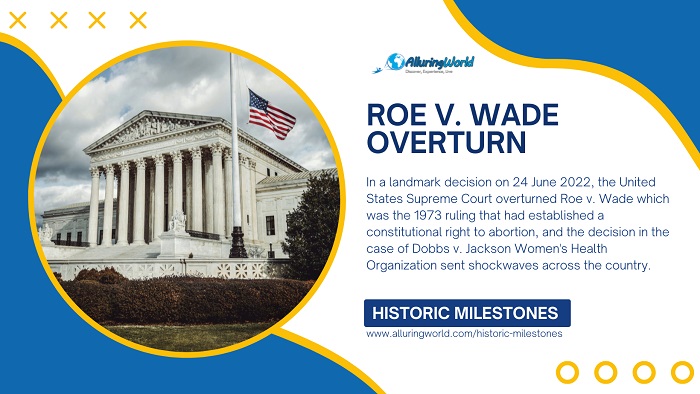Read time ca. 5 minutes
In a landmark decision on 24 June 2022, the United States Supreme Court overturned Roe v. Wade which was the 1973 ruling that had established a constitutional right to abortion, and the decision in the case of Dobbs v. Jackson Women’s Health Organization sent shockwaves across the country, fundamentally altering the legal landscape of reproductive rights and sparking widespread debate and activism.
The Dobbs Decision:
The Dobbs v. Jackson Women’s Health Organization case revolved around a Mississippi law that prohibited most abortions after 15 weeks of pregnancy, and this case presented a direct challenge to the landmark Roe v. Wade decision from 1973 which established a constitutional right to abortion. In a quite unfortunate 6-3 ruling, the Supreme Court overturned Roe v. Wade and Planned Parenthood v. Casey, the 1992 decision that reaffirmed Roe’s core holding, and this landmark decision effectively eliminated the federal constitutional right to abortion, returning the authority to regulate abortion to individual states.
The majority opinion as it was authored by Justice Samuel Alito, asserted that the Constitution does not explicitly confer a right to abortion, and the Court argued that the right to abortion was not deeply rooted in the nation’s history and traditions, where they went even further to say that Roe v. Wade decision had been wrongly decided. Still, the Dobbs decision has had a profound impact on reproductive rights in the United States, with some states enacting near-total bans on abortion while others have enshrined abortion rights into state law.
Immediate Impact:
Sadly, the Dobbs decision had a profound and immediate impact on abortion access across the United States, so by overturning Roe v. Wade, the Supreme Court effectively dismantled the federal protections for abortion rights that had been in place for nearly 50 years, and in addition to all that, this ruling created a patchwork of state laws where each state was now having the authority to regulate abortion as it sees fit.
Following the Dobbs decision, as expected what would happen in several states since many of which had pre-existing trigger laws, swiftly moved to ban or severely restrict access to abortion. These bans often have limited exceptions, such as in cases of rape, incest, or to save the life of the pregnant person, but conversely, other states have taken steps to protect and expand access to abortion as they enshrined abortion rights into state law or providing funding for abortion services. Since this has resulted in a significant disparity in abortion access across the country, there are individuals in some states who are facing severe restrictions while those in others retain access to safe and legal abortion care.
Public Reaction and Protests:
This, as expected, ignited a fierce and multifaceted national debate where pro-life advocates celebrated the ruling as a historic victory, viewing it as a triumph for the sanctity of life and a restoration of states’ rights to regulate abortion within their borders, while pro-choice supporters condemned the ruling as a grave setback for women’s rights and bodily autonomy. The pro-lifers argued that the decision returned the power to make crucial decisions about reproductive healthcare back to the people and their elected representatives at the state level, while pro-choicers argued that the decision denied women control over their own bodies and reproductive health, disproportionately impacting marginalized communities and exacerbating existing health disparities. In the manner that the ruling sparked widespread protests and demonstrations across the nation, with passionate displays of both support and opposition, these demonstrations underscored the deep societal divide on the issue of abortion, and they highlighted the deeply held and often conflicting moral, ethical, and political beliefs that shape public opinion on this complex and highly charged topic.
Legal and Political Ramifications:
Because there are profound legal and political consequences, legally this overturn has triggered a wave of legal challenges and legislative activity across the country because numerous states have enacted restrictive abortion laws, while others have sought to protect abortion access. These legal battles are playing out in state courts, with varying degrees of success for both sides, and simultaneously, Congress has seen intense debate and legislative efforts to codify abortion rights at the federal level, though these efforts have been largely unsuccessful due to political gridlock.
Politically, the Dobbs decision has ignited a fierce national debate, energizing voters and advocacy groups on both sides of the issue, and the ruling has become a central campaign issue in numerous elections and it also influenced voter turnout and contributed to political polarization. The decision has also raised concerns about the potential erosion of other fundamental rights, such as access to contraception and same-sex marriage, and these concerns stem from the legal doctrine of “substantive due process” which the Dobbs decision arguably weakened, raising questions about the future of other rights recognized under this doctrine.
Conclusion:
To sum up everything, the overturning of Roe v. Wade marks a pivotal moment in American history since it reshaped the legal and cultural landscape of reproductive rights where the decision has set in motion a complex and ongoing struggle over abortion access, reflecting deep-seated ideological differences. As the nation grapples with the consequences of this ruling, the debate over reproductive rights continues to be a central and contentious issue in American public life.

